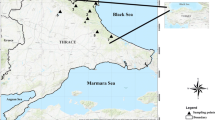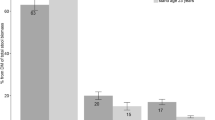Abstract
Pollarding of oak trees for livestock and animal feeding is a traditional application, and it has been used for centuries from generation to generation in southern and southeastern Turkey. Estimation of the fresh sprout biomass (FSB) potential of pollarded oak forests in high accuracy is important for sustainable forest management. In the present study, 40 trees were sampled from Turkey oak (Quercus cerris L.) stands that have been irregularly pollarded for animal husbandry in Adıyaman, southeastern Turkey. In order to estimate FSB, a multiple logarithmic linear model was developed with explanatory variables such as tree diameter at breast height (DBH), total tree height (H), mean sprout length (SL), and mean sprout age (SA), which are in a significant relationship with FSB. Stepwise multiple regression analysis was used to fit this multiple logarithmic linear model and to determine the best independent variable set. As a result of stepwise regression analysis, three models were obtained in which SL, DBH, and SA are independent variables. Model 1 estimates the FSB by taking only SL, Model 2 uses SL and DBH, and Model 3 uses SL, DBH, and SA as independent variables. All models were significant at p = 0.001 level. Model 1 explained the variation in FSB by 65%, Model 2 by 81%, and Model 3 by 86%. Inclusion of DBH in the model (Model 2) decreased the mean absolute error (MAE) of FSB by 26% and the inclusion of SA (Model 3) decreased MAE by 43%.





Similar content being viewed by others
References
Bayen, P., Bognounou, F., Lykke, A. M., Ouédraogo, M., & Thiombiano, A. (2016). The use of biomass production and allometric models to estimate carbon sequestration of Jatropha curcas L. plantations in western Burkina Faso. Environment, Development and Sustainability, 18(1), 143–156.
Burner, D. M., Pote, D. H., & Ares, A. (2006). Foliar and shoot allometry of pollarded black locust, Robinia pseudoacacia L. Agroforestry Systems, 68(1), 37–42.
Calvo-Alvarado, J. C., McDowell, N. G., & Waring, R. H. (2008). Allometric relationships predicting foliar biomass and leaf area: sapwood area ratio from tree height in five Costa Rican rain forest species. Tree Physiology, 28, 1601–1608.
Cienciala, E., Apltauer, J., Exnerová, Z., & Tatarinov, F. (2008). Biomass functions applicable to oak trees grown in Central-European forestry. Journal of Forest Science, 54(3), 109–120.
Fidan, C., Taşdemir, C., Karatay, H., & Duran, C. (1998). Doğu Anadolu bozuk meşe baltaliklarinin Imari ve silvo-pastoral amaçli kullanim imkanlari. Rehabilitation of degraded oak coppice and usage opportunities for silvo-pastoral purpose. Southeastern Anatolia Forestry Research Institute Elazığ – Turkey, Teknik Bülten No:12, ISSN: 1301-9538, 37p (in Turkish with English summary).
Franzel, S., Carsan, S., Lukuyu, B., Sinja, J., & Wambugu, C. (2014). Fodder trees for improving livestock productivity and smallholder livelihoods in Africa. Current Opinion in Environmental Sustainability, 6, 98–103.
Geta, T., Nigatu, L., & Animut, G. (2014). Evaluation of potential yield and chemical composition of selected indigenous multi-purpose fodder trees in three districts of Wolayta Zone, Southern Ethiopia. World Applied Sciences Journal, 31, 399–405.
Ghahramany, L., Shakeri, Z., Ghalavand, E., & Ghazanfari, H. (2017). Does diameter increment of Lebanon oak trees (Quercus libani Oliv.) affected by pollarding in Northern Zagros, Iran? Agroforestry Systems, 91, 741–748.
Ghani, I. M. M., & Ahmad, S. (2010). Stepwise multiple regression method to forecast fish landing. Procedia - Social and Behavioral Sciences, 8, 549–554.
Ghazanfari, H., Namiranian, M., Sobhani, H., Marvi Mohajer, M. R., & Pourtahmasi, K. (2003). Estimation of tree diameter growth of Lebanon oak (Quercus libani) in northern Zagros forests (case study: Havareh Khol). Iranian Journal of Natural Resources, 57, 649–662.
Gill, D. S., Amthor, J. S., & Bormann, F. H. (1998). Leaf phenology, photosynthesis, and the persistence of saplings and shrubs in a mature northern hardwood forest. Tree Physiology, 18, 281–289.
Guyassa, E., Raj, A. J., Gidey, K., & Tadesse, A. (2014). Domestication of indigenous fruit and fodder trees/shrubs in dryland agroforestry and its implication on food security. International Journal of Ecosystem, 4, 83–88.
Jazib, M. J. (2015). Oak: a multipurpose tree species of the Pir Panjal Himalayas facing grave threats. Middle East Journal of Scientific Research, 23, 665–669.
Kenzo, T., Furutani, R., Hattori, D., Kendawang, J. J., Tanaka, S., Sakurai, K., & Ninomiya, I. (2009). Allometric equations for accurate estimation of above-ground biomass in logged-over tropical rainforests in Sarawak, Malaysia. Journal of Forest Research, 14(6), 365–372.
Khedri, L., Ghahramany, L., Ghazanfari, H., & Pulido Díaz, F. J. (2017). A quantitative study of pollarding process in silvopastoral systems of Northern Zagros, Iran. Forest Systems, 26(3), e018.
Lang, P., Jeschke, M., Wommelsdorf, T., Backes, T., Lv, C., Zhang, X., & Frank, M. T. (2015). Wood harvest by pollarding exerts long-term effects on Populus euphratica stands in riparian forests at the Tarim River, NW China. Forest Ecology and Management, 353, 87–96.
Li, Y., Li, C., Li, M., & Liu, Z. (2019). Influence of variable selection and forest type on forest aboveground biomass estimation using machine learning algorithms. Forests, 10(12), 1073.
Mac Cracken, J. G., & van Ballenberghe, V. (1993). Mass–diameter regressions for moose browse on the Copper River Delta, Alaska. Journal of Range Management, 46, 302–308.
Makineci, E., Ozdemir, E., Caliskan, S., Yilmaz, E., Kumbasli, M., Keten, A., Beskardes, V., Zengin, H., & Yilmaz, H. (2015). Ecosystem carbon pools of coppice-originated oak forests at different development stages. European Journal of Forest Research, 134(2), 319–333.
Marklund, L. G. (1987). Biomass functions for Norway spruce (Picea abies (L.) Karst.) in Sweden. [Report.] Umea, Department of Forest Survey. Swedish University of Agricultural Sciences: 43.
Mol, T. (1982). Elazığ ormanlarında yemlik yaprak yararlanmasının orman ağaçlarına etkileri. İ.Ü. Orman Fak. Yayınları. İ.Ü. Yayın No.: 2911, O.F. Yayın No.: 316, Taş Matbaası, Istanbul-Turkey (in Turkish).
Nordén B., Jordal, J. B., & Evju, M. (2018). Can large unmanaged trees replace ancient pollarded trees as habitats for lichenized fungi, non-lichenized fungi and bryophytes? Biodiversity and Conservation, 27(5), 1095-1114.
OGM. (2014). Orman Genel Müdürlüğü. Şanlıurfa 337pp: Şanlıurfa Orman Bölge Müdürlüğü (in Turkish).
Ozdemir, E., Makineci, E., Yilmaz, E., Kumbasli, M., Caliskan, S., Beskardes, V., Keten, A., Zengin, H., & Yilmaz, H. (2019). Biomass estimation of individual trees for coppice-originated oak forests. European Journal of Forest Research, 138(4), 623–637.
Peri, P. L., Dube, F., & Varella, A. C. (2016). Opportunities and challenges for silvopastoral systems in the subtropical and temperate zones of South America. In Silvopastoral Systems in Southern South America (pp. 257–270). Cham: Springer.
Pinkard, E. A., & Beadle, C. L. (1998). Aboveground biomass partitioning and crown architecture of Eucalyptus nitens following green pruning. Canadian Journal of Forest Research, 28, 1419–1428.
Pinkard, E. A., Battaglia, M., Beadle, C. L., & Sands, P. J. (1999). Modeling the effect of physiological responses to green pruning on net biomass production of Eucalyptus nitens. Tree Physiology, 19, 1–12.
Pulido, F. J., Díaz, M., & Hidalgo de Trucios, S. J. (2001). Size structure and regeneration of Spanish holm oak Quercus ilex forests and dehesas: effects of agroforestry use on their long-term sustainability. Forest Ecology and Management, 146, 1–13.
R Core Team (2019). R: A language and environment for statistical computing. R Foundation for Statistical Computing, Vienna, Austria. URL https://www.R-project.org/
Ranjbar, A., Ghahramany, L., & Pourhashemi, M. (2012). Impact assessment of pollarding on biometrical indices of Lebanon oak (Quercus libani Oliv.) in Belake Forests, Baneh. Iranian Journal of Forest and Poplar Research, 20, 578–594.
Rozas, V. (2003). Tree age estimates in Fagus sylvatica and Quercus robur: testing previous and improved methods. Plant Ecology, 167, 193–212.
Rozas, V. (2004). A dendroecological reconstruction of age structure and past management in an old-growth pollarded parkland in northern Spain. Forest Ecology and Management, 195(1–2), 205–219.
Rozas, V. (2005). Dendrochronology of pedunculate oak (Quercus robur L.) in an old-growth pollarded woodland in northern Spain: establishment patterns and the management history. Annals of Forest Science, 62, 13–22.
Saglam, S., Ozdemir, E., Ozkan, U. Y., Demirel, T., & Makineci, E. (2020). Biomass estimation of aboveground tree components for Turkey oak (Quercus cerris L.) in south-eastern Turkey. Environmental Monitoring and Assessment, 192, 418.
Salis, S. M., Assis, M. A., Mattos, P. P., & Pião, A. C. S. (2006). Estimating the aboveground biomass and wood volume of savanna woodlands in Brazil’s Pantanal wetlands based on allometric correlations. Forest Ecology and Management, 228, 61–68.
Sawadogo, L., Savadogo, P., Tiveau, D., Dayamba, S. D., Zida, D., Nouvellet, Y., & Guinko, S. (2010). Allometric prediction of above-ground biomass of eleven woody tree species in the Sudanian savanna-woodland of West Africa. Journal of Forest Research, 21, 475–481.
Sevimsoy, M., & Sun, O. (1987). Doğu ve Güneydoğu Anadolu’daki Meşe Baltalıkları, Orman İçi Meralarından Hayvan Beslenmesi Yönünden Faydalanma ve Buna İlişkin Ekonometrik Araştırmalar. Ormancılık Enstitüsü Yayınları, Teknik Bülten No.: 183. (in Turkish).
Shahabedini, S., Ghahramany, L., Pulido, F., Khosravi, S., & Moreno, G. (2018). Estimating leaf biomass of pollarded Lebanon oak in open silvopastoral systems using allometric equations. Trees, 32(1), 99–108.
Smith, J., Pearce, B., & Wolfe, M. (2012). A European perspective for developing modern multifunctional agroforestry systems for sustainable intensification. Renewable Agriculture and Food Systems, 27, 323–332.
Tobin, B., Black, K., Osborne, B., Reidy, B., Bolger, T., & Nieuwenhuis, M. (2006). Assessment of allometric algorithms for estimating leaf biomass, leaf area index and litter fall in different-aged Sitka spruce forests. Forestry, 79, 453–465.
Tolunay, A., Adıyaman, E., Akyol, A., İnce, D., Türkoğlu, T., & Ayhan, V. (2014). An investigation on forage yield capacity of Kermes oak (Quercus coccifera L.) and grazing planning of Mediterranean maquis scrublands for traditional goat farming. The Scientific World Journal, 2014.
Valipour, A., Plieninger, T., Shakeri, Z., Ghazanfari, H., Namiranian, M., & Lexer, M. J. (2014). Traditional silvopastoral management and its effects on forest stand structure in northern Zagros, Iran. Forest Ecology and Management, 327, 221–230.
Wang, C. (2006). Biomass allometric equations for 10 co-occurring tree species in Chinese temperate forests. Forest Ecology and Management, 222, 9–16.
Youkhana, A., & Idol, T. (2008). First-year biomass production and soil improvement in Leucaena and Robinia stands under different pollarding systems. Journal of Tropical Forest Science, 2008, 181–187.
Acknowledgements
We thank to Adıyaman Regional Directorate of Turkish Forest Service for helps in field. We also thank to Dr. Hatice YILMAZ from Istanbul University- Cerrahpasa, Vocational School, for determination of oak species.
Author information
Authors and Affiliations
Corresponding author
Additional information
Publisher’s note
Springer Nature remains neutral with regard to jurisdictional claims in published maps and institutional affiliations.
Rights and permissions
About this article
Cite this article
Saglam, S., Ozdemir, E., Ozkan, U.Y. et al. Estimation of fresh sprout biomass based on tree variables of pollarding Turkey oak (Quercus cerris L.). Environ Monit Assess 193, 83 (2021). https://doi.org/10.1007/s10661-021-08882-w
Received:
Accepted:
Published:
DOI: https://doi.org/10.1007/s10661-021-08882-w




